IMNature
The Newsletter for IMN Hosts and certified graduates
2024 Spring Edition
 |
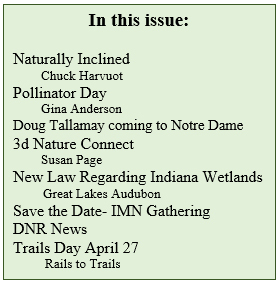
Last fall, I agreed to become a 3-day a week substitute teacher at one of the local elementary schools. I realize that there are some, including members of my family, that might question my sanity for doing so—and a few times that would include me; but so far, I’ve survived, and on several occasions have really enjoyed my assignments. One of those days was February 2. I spent part of my day with one of the kindergarten classes. They had made paper headbands that looked like a groundhog to celebrate Groundhog’s Day. The headbands were cute and the students were excited about wearing them. Most of the students didn’t seem to have a clue about groundhogs, so I explained as best I could about the implications of the day. That got me to thinking about groundhogs and how this tradition got started.
Evidently, Pennsylvania Dutch immigrants observed a German tradition of celebrating Candlemas (February 2), a festival of light. Somehow, a badger seeing its shadow on a sunny day got worked into the holiday, and it meant four more weeks of winter. The folks in Pennsylvania extended the forecast from four to six weeks, and replaced the badger with a groundhog. The first published “news report” of a groundhog seeing its shadow appeared in the Punxsutawney Spirit newspaper in 1886. The following year it became an “official” event when a group of people went to Gobbler’s Knob to check on the local groundhog. Although it isn’t mentioned much anymore, early interest in the groundhog was as a game animal for food with “Groundhog Feasts” later in the year. When interest in the feasts declined, that part of the celebration ended.
The largest and most famous celebration is in Punxsutawney, Pennsylvania, attracting up to 40,000 people (the local population is about 6,000), and people start lining-up before 6 am to watch Punxsutawney Phil do his thing. Although the best known, Phil, (who didn’t really have a name until 1961), isn’t the only groundhog forecaster around. There’s also Buckeye Chuck in Ohio, French Creek Freddie in West Virginia, Woodstock Willie in Illinois, and Sun Prairie Jimmy in Wisconsin- who bit the ear of the town’s mayor in 2015. Canada also celebrates Groundhog’s Day with Shubenacadie Sam in Nova Scotia, Wiarton Willie in Ontario and Fred la marmotte in Quebec. So why do all the groundhog forecasters seem to be males? Probably because the males leave their dens about two weeks before the females. However, there are some female forecasters out there: Great Neck Greta in New York, Ms. G in Massachusetts, Gertie in Illinois, Lady Edwina in New Jersey (she replaced Essex Ed when he retired) and here in Indiana there’s Dandy in Delphi (who reportedly slept through the event this year).
So, are groundhogs really an accurate way of predicting the arrival of Spring? Not really. Phil’s accuracy rate is about 38%, which seems to be typical of most males. Females seem to be slightly better at about 40%, but that depends a bit on when they come out of their den- February 2 or two weeks later. Despite all the forecasting fanfare, scientists suggest that male groundhogs actually come out to search for a mate. They try to locate a female’s den, then go back and sleep for another month, until mating season starts in March.
Groundhogs, or Marmota monax, are members of a subgroup of the squirrel family. They are widely distributed across North America, and live in underground burrows that can be 8 to 60 feet long, with more than one entrance and several rooms—including a bathroom. Adults tend to be solitary, except during mating season. Females usually give birth to litters of three to six pups (or kits) in April. Pups are born hairless, and their only working senses at birth are smell and touch. The pup’s eyes open at 4 weeks, are weaned at about seven weeks and start to leave home as early as two months. Groundhogs, also called woodchucks or whistle pigs, gorge themselves on grasses, plants, fruit and farmer’s crops during the summer to build-up reserves of fat to prepare for their winter hibernation. During the three-to-four-month hibernation their heart rate decreases (from 80 to 5 beats per minute) and their body temperature drops to about 37°, only slightly warmer than the temperature inside the burrow.
My initial groundhog sighting this year was February 18, (it’s a female because it had a litter of three last summer). I was alerted by my dog, Molly, who despite frequent reminders that she’s a Pointer and really a bird dog, goes into a barking frenzy whenever she sees one. It was a bright sunny afternoon, and the groundhog did not stay out long—so maybe seeing its shadow does have something to do with it. All was quiet until March 13, when Molly saw her again. This time it stayed out eating away, until I got tired of the barking and went outside to scare it. “My” groundhog, (no, I have not named her), has a burrow under some low shrubs on the east side of my lot. The neighbor to the east of me has one with a burrow on the far side of his lot along his fence line, the neighbor to the west has a burrow under his stone wall, and there are a number of holes across the road in the farmer’s field. Molly has plenty of opportunities to bark—and she does. Other than the barking, I have not had any issues with the local population. That might change if I discover digging close to the house or in the yard.
I did learn a few interesting tidbits: groundhogs actually drink very little water, they get what moisture they need from the plants they eat, (they can eat one pound of plants a day); as members of the squirrel family, they can, and will climb trees; they are good swimmers—all that fat may serve as flotation; they have two layers of fur, a dense undercoat and a longer outercoat; and, not surprisingly, their favorite activities seem to be eating and sleeping.
I have always felt fortunate to live where there is a change of seasons; and in their own way, groundhogs are a sign of the coming Spring. Whether they are accurate with their forecasts, or not, I know when they start to come out of their burrows, Spring is not too far behind.
|
 |
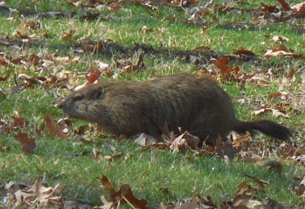 |
 Pollinator Day is Buzzing with Activity
On April 27, 2024 Purdue Extension Floyd County and Sunnyside Master Gardeners will host Pollinator Day! This free, family-friendly event will be from 10 a.m.- 3 p.m. on the lawn of the Purdue Research Park of Southeast Indiana (3000 Technology Ave., New Albany, IN 47150), weather permitting.
Classes will be held on How to Catch a Swarm of Bees presented by Spring Valley Beekeepers, and Pollinators and the Big Picture presented by Kevin Wiener from the All Bugs Go to Kevin Facebook page.
Other activities include booths on Native Bees, Butterflies, Pollinators and Our Food Supply, Hummingbirds, Native Plants, Planting for Pollinators, Beeswax Lip Balm, a Pollinator Selfie Booth, Pollinator Putt Putt, and much more.
Please follow Purdue Extension Floyd County on Facebook and Instagram for more details about this event. If you have questions, please contact Gina Anderson, ANR Extension Educator-Floyd County, at 812-948-5470 or gmanders@purdue.edu. If you are in need of accommodations to attend this program, please contact Gina Anderson prior to the event at 812-948-5470 or gmanders@purdue.edu by April 14.
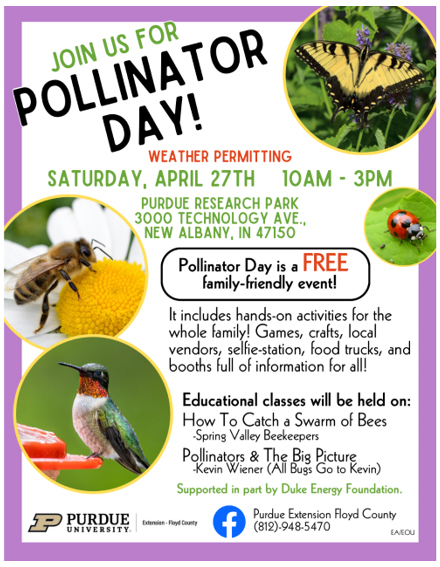 |
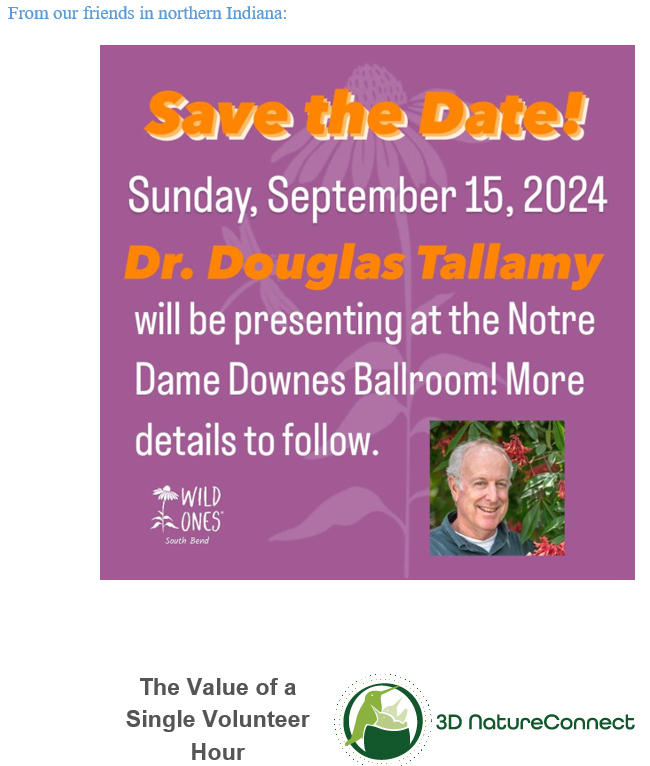 Did you know that the value of a volunteer hour for the state of Indiana is $28.84? Have you joined the new Indiana Master Naturalist platform yet? 3D Nature Connect is a new platform and tool that you can use by computer or phone to search for volunteer activities, create projects to recruit volunteers, log hours, and more.
Using the platform gives Jody and the DNR much better reporting options about what the Indiana Master Naturalist Program is doing. All of the hours that you enter into 3D NatureConnect for volunteer activity for the IMN program can be converted to a value (outside of the obvious and important value of your actual work), to help promote the Indiana Master Naturalist Program and provide funding for it.
Even if you are not working on a certification, we hope you will add every hour, even if it's only 1-2 hours, to the platform. You are extending the value of your volunteer work by helping to give an aggregate value to IMN and the Indiana DNR. If you are not on the platform yet, it's free to IMN members. All you have to do is reach out to shpage@3dnatureconnect.org to get signed up. You can learn more by visiting www.3dnatureconnect.org or watching a video here or here.

Governor Holcomb Signs SB 246 Into Law, Incentivizing Private Landowners to Protect Wetlands
Attributable to Policy Director of Freshwater for Audubon Great Lakes, Brian Vigue
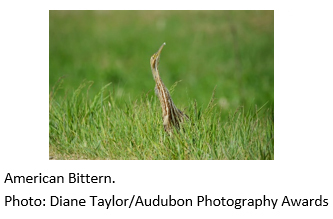
"The Indiana Legislature has taken a step in the right direction for wildlife and communities that depend on Indiana’s wetlands.
SB 246, signed into law yesterday by Gov. Holcomb and introduced by Sen. Sue Glick (R-LaGrange), will encourage landowners to protect wetlands on their property by allowing some privately owned wetlands to be given “wildland” status, which qualifies them for tax breaks.
The overwhelming majority of Indiana’s wetlands are on private land, and encouraging landowners to preserve them is one tool to keep state wetlands safe. That’s important because wetlands protection pays dividends. Among their benefits, wetlands provide habitat for vulnerable marsh birds, and protect communities from flooding. Communities like Tipton, IN, which suffered catastrophic flooding in 2013, serve as notable examples of what can happen when wetlands, and their water storage potential, are lost.
While we are deeply disappointed in the passage of HB 1383 into law, we are encouraged to see Indiana lawmakers working to advance solutions to protect these vital natural resources. We will continue our work with lawmakers to achieve comprehensive wetland policy that is good for all Hoosiers.”
|
 September 27-28, 2024, in Fort Wayne. More details to come soon!
The 2025 Gathering will be at Brown County State Park, April 4-5, 2025.
News from the Indiana DNR:
Angler catches state record smallmouth bass on Monroe Lake
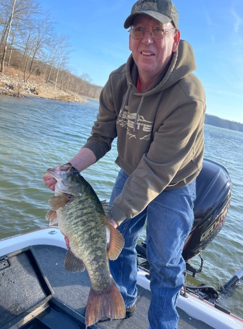
Hoosier angler Rex Remington caught an 8-pound, 4-ounce smallmouth bass on Monroe Lake on March 3, smashing the previous record set in 1992 at Twin Lake in LaGrange County by one pound. The new record fish was released alive back into Monroe Lake.
Smallmouth bass are one of Indiana’s three species of black bass, along with largemouth bass and spotted bass. Pound for pound, smallmouth are known among anglers as the most spirited fighters of the black bass. Many anglers associate smallmouth bass with streams and natural lakes, but several Indiana reservoirs consistently have smallmouth catches, including Patoka and Brookville in addition to Monroe.
Fishing for smallmouth in lakes is best in early spring, as they feed aggressively before spawning. As water temperatures warm, smallmouth move into rocky points and flat rocky areas. They are opportunistic carnivores, consuming insects, crayfish, and fish. Lures that imitate prey, such as spinnerbaits, crayfish-patterned crankbaits, surface lures, and live minnows or crayfish are effective.
Monroe Lake, in Monroe County just 10 miles south of Bloomington, is Indiana’s largest reservoir at 10,750 acres and has nine public boat ramps. More information is at on.IN.gov/monroelake.
To learn more about the Indiana Record Fish Program, please see on.IN.gov/recordfish.
Learn about purchasing a fishing license at on.IN.gov/fishinglicense.
|
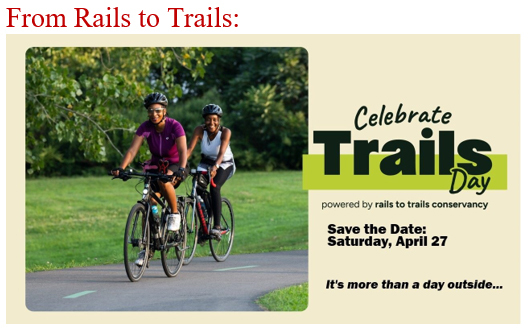 Celebrate Trails Day is coming up on Saturday, April 27
On the fourth Saturday of every April, we invite everyone to celebrate America’s trails with us by spending time outside on their local trails. Whether you’re new to trails or have been using them all year long, everyone is welcome to join the party.
Plus, you can win a jumbo-sized goody bag filled with great prizes from RTC and the 2024 Celebrate Trails Day sponsors and supporters by joining the celebration!
Will we see you out there? Let us know and be entered to win!
We’re teaming up with our partners to bring the celebration to communities nationwide. As we get closer to the big day, we’ll let you know about events planned on trails around the country and share other ways to get involved
Plan to celebrate trails on April 27
Celebrate Trails Day is more than a day outside. It’s an opportunity to take a moment to connect with friends, family, your fellow neighbors—or to take some time for yourself—and experience, firsthand, the joy of trails and the impact they can have on people, places, and the planet.
We hope to see you on the trails!
Sincerely,
Suzanne Matyas
 The Indiana Master Naturalist program is sponsored by the Resource Conservation & Development Councils, Indiana Soil & Water Conservation Districts, Purdue Cooperative Extension Service, and Indiana Department of Natural Resources. www.indianamasternaturalist.org
|












